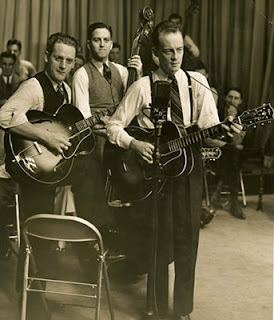82 years and 5 days ago today, Hoagy Carmichael recorded a new song he wrote the music for and it was called Georgia On My Mind. 52 years ago this month the best known recording of the song was released and that was by Ray Charles. Ray set the standard for the song and I'm not going to even look at the hundreds of recordings of the song that have been made since September 1960, but let's take a look at the first 30 years of the song leading up to Ray's recording.
It's been written that bandleader Frankie Trumbauer suggested to Hoagy Carmichael that he compose a song called "Georgia" as songs about the South seemed to do pretty well at that time. Carmichael took his suggestion to heart and composed the song and when his college buddy Stuart Gorrell heard the melody he wrote the lyrics to it. Gorrell never wrote another song and went into a long career in banking. Think about it.....the song has been around 82 years and remains popular today and it was his one and only stab at writing a lyric. Carmichael had a sister Georgia and Gorrell stated that it was written about her but intentionally made ambiguous to sound like it could be about both the state and a woman.
Carmichael's orchestra recorded it in New York City on Sept. 15, 1930 with Hoagy doing the vocals. Featured on the recording is the famous cornet of Bix Beiderbecke. It was his last recording session before his untimely death.
Hoagy's recording didn't do much. Frankie Trumbauer, the guy that suggested to Hoagy he write a song called Georgia, recorded it in Chicago with his orchestra on Sept. 24, 1931. It came out on the Brunswick label and was the first big hit of the song. To be honest, I haven't a clue as to who did the vocals on the recording. Frankie, a sax player, had a lot of success in the 1920's and 1930's in the flourishing field of jazz. He was also a highly skilled aviator and during the war pretty much walked away from music to work for the Civil Aeronautics Authority, be a test pilot for North American Aviation and to be a flight trainer for the B-25 bomber. He died suddenly in 1956 at the age of 55.
Two other famous recordings of Georgia were made in November of that year (1931). On Thursday, November 5, Louis Armstrong cut it and for the first time it received a more relaxed and flowing interpretation although it still had that steady "boom-boom-boom" rhythm.
On Tuesday, the 24th of November, the Paul Whiteman Orchestra cut it with Mildred Bailey handling the vocals which was the first female take on the song. What makes this recording unique is it opens with a verse not heard before, or since, where other recordings start it off with the chorus.
In 1936 famed French jazz guitarist Django Reinhardt recorded it.
During the first 30 years of Georgia On My Mind it was almost recorded as an instrumental as often as a vocal. Here's the 1940 recording by the Glenn Miller Orchestra.
In March 1941, only 9 days apart, two very influential recordings were made of Georgia On My Mind and both featured female singers. The first, on March 12, was done by the Gene Krupa Orchestra featuring Anita O'Day. This is a very nice up-tempo take on the song showing the potential for things to come after the war when it became a favorite of many jazz-flavored singers.
On March 21 the Eddie Heywood Orchestra recorded it with Billie Holiday on vocals. A very bluesy performance and with these two March 1941 recordings the song finally lost that steady 1-2-3-4 clipped rhythm.
In 1946 the song was cut by Jo Stafford for Capitol. Very bluesy, it was no doubt a big influence on Ray Charles 14 years later. For that matter, it appeared on a Jo Stafford "78" album with 5 other songs in 1946, one of which was Carry Me Back To Old Virginny which was also the b-side of Ray's recording of Georgia in 1960.
In the 1950's there were many recordings of Georgia On My Mind including some done by some of the biggest singers of the decade. A lot of them were pretty horrible too. I won't name names. If they weren't singing it as a finger-snapping Vegas lounge debacle, they were singing it minus anything Anita, Billie and Jo gave it in the 40's. I was going to add a couple examples, but why ruin it? In September 1960 Ray's recording was issued and in the 52 years since it has remained a favorite of singers in all genres.

















































